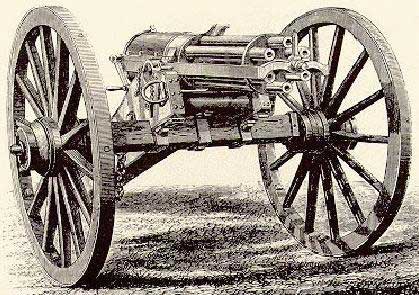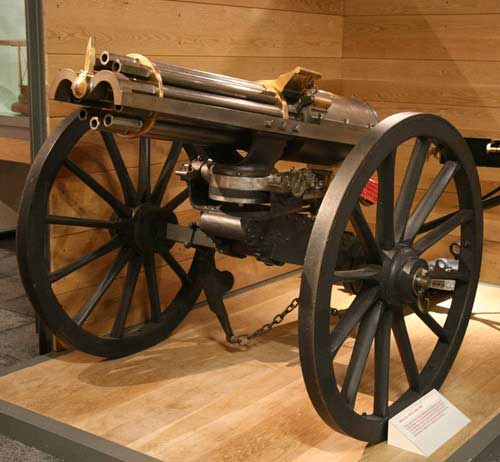Ever since firearms were invented, did men try to make them shoot faster. The big change from muzzleloading arms to breechloaders was stimulated by the fact the newer arms could accomplish this aim.
Several designs were tried, some like the infamous Puckle Gun which failed miserably. But multibarreled actions of one kind or another seemed to be the path because of overheating fears. Volley guns were tried but were nightmares to reload.

An American, Dr. Richard Gatling, was working on his idea of a machine gun, and produced a working prototype by 1862. He had the usual inventor troubles getting it to work properly, then hit on copper self contained cartridges, the break through he needed. He offered it to the U.S. Army, embroiled in the Civil War at the time, and was turned down by the less than forward looking Chief of Ordinance.
By 1865, the redesigned (again) Gatling was a contender. Each barrel had it's own bolt, striker and extractor making it 6 complete rifles fired and reloaded in rapid succession by turning a hand crank. Later designs had 10 barrels. The gravity feed hopper was probably it's greatest asset. The Gatling could sustain a faster rate of fire than the competing designs, like the French Mitrailleuse.

The British adopted it around 1871, and since they were embroiled in many colonial actions of the time, it was immediately employed. It's effect on native formations was devastating. The gun was used as a field piece, from the weight of the gun and size of the carriage, which left the gun crew exposed. This was more of a drawback against European armies than native ones though, as the 3rd world countries had little artillery and few snipers.
The British may have been heavy handed against their colonial foes, but must be seen in the context of their time. Americans could be said to have been the same way, using B-52's against the North Vietnamese. The effect would have been the same. Native populations had some success against the British, but in the long run, they had no chance. The colonial period had to run it's course before these countries could hope to rule themselves.

picture taken by Max Smith
The first use of British Gatlings was the Battle of Ulundi. The Brits, still reeling from the defeat at Isandlwana, threw the kitchen sink at the Zulus, who were already down and out. On July 4th, 1879, 17,000 British and Native troops, armed with cannon and gatlings, met up with 24,000 Zulus armed with spears and old muskets. Thousands of Zulus surrounded the British and charged from all sides. It only took a half hour of concentrated firepower before the Zulus had enough. The rise of the British Gatling Gun and the end of the Zulu Nation happened on the same day.
The Gatlings continued to serve till newer designs eclipsed them. Using human energy to run the gun never was a satisfactory arrangement. With recoil and gas operated guns on the rise, the Galtlings were slowly discontinued. Even though Gatling himself adapted an electric motor to the Gatling Gun, it didn't really take off. It wasn't to be seen again till the rise of the minigun in the 60's, and the rotating barrel machine gun is now the most devastating bullet throwning gun on the planet.
National Geographic video on Gatlings

